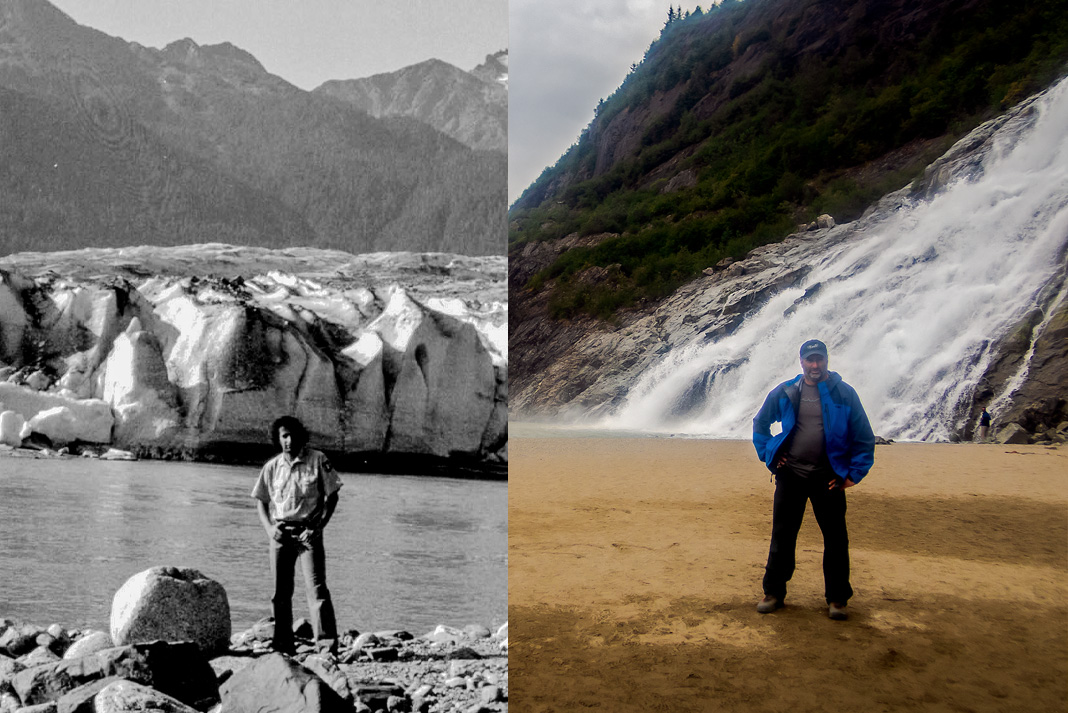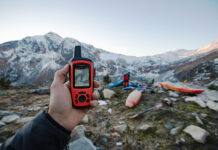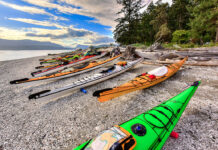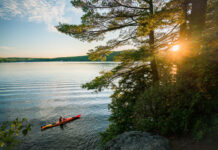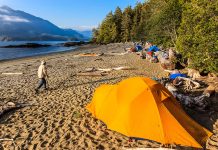I’m looking for my lunch rock from 30 years ago. The summer Germany reunified after the Berlin Wall came down, I worked at an Alaskan visitor center at a two-mile-wide glacier that rolls into suburban Juneau. On sunny days I’d eat lunch on a flat rock on the lakeshore and see if the glacier would calve an iceberg or two. Back for the first time three decades later, I’m thinking less about glaciology than Greek philosophy.
As Heraclitus said, “No man ever steps in the same river twice, for it’s not the same river and he’s not the same man.” The same could be said of glaciers. And paddlers.
Back in 1990, the Mendenhall Glacier was retreating 30 feet a year. That’s obviously accelerated—30 years times 30 feet would be less than a fifth of a mile, and the Mendenhall is more than a mile back from where it was. My lunch spot has been overgrown by willows. A trail takes us to Nugget Falls, which used to be unreachable, wedged in a hollow in the glacier back in the day.
Nobody is shocked glaciers change and melt. Glaciers are frozen rivers, and they behave like rivers, just more slowly. I knew about the Mendenhall’s retreat from Google Earth and news about climate change. But when change is so stark, it’s a wake-up to all the time passed. It’s also a visit to my birth as a sea kayaker.
I’m not the same man I was in 1990. Mostly for the better, except for some missing knee cartilage and a hairline that, like the glacier, has receded. I did feel old when the young ranger with my old job congratulated me, scruffy after two weeks in the backcountry, for “still being on the right side of the ground.”
Mendenhall Lake is where I first scooted my butt into a sea kayak. I’d grown up canoeing in the Eastern U.S. and Canada and learned whitewater in Oregon and Scotland. When I came to the Alaska Panhandle, the endless inlets and the lake filled with icebergs at work every day made me feel like the kid with his nose against the candy store window.
Eventually, one of my co-workers took pity on me and let me borrow his old kayak, and his old truck to transport it. We’d paddle across the lake to an island that was partly underneath the ice—now a massive peninsula—and we’d hike across to the glacial face. When we could manage the logistics, we’d borrow or rent kayaks and paddle in the glacial fjords. It was a minor diversion from spending my time hiking, since I didn’t have a kayak or a car, and Juneau’s trails were accessible by bus and bike. But it stuck with me.
In the decades since, glaciers were absent from my paddling experience. This was my first return to Alaska to paddle among the tidewater glaciers and icebergs. The shape of icebergs became instantly familiar and entrancing, even after a long melting period. I remembered watching ping-pong ball-sized arctic terns chase off bald eagles perched on the bergs to feed on salmon runs. I was absurdly thrilled my favorite pizza joint is still in business, even though a tram now carries cruise ship tourists up my favorite mountain.
We easily miss gradual changes, like tides rising inch by inch or glaciers receding a few feet a year. It’s when we see the sudden change—in this case, a 30-year time-lapse—we take stock. In the past three decades, I’ve gone from occasional to dedicated paddler, from young man to middle age, from grasping for my place in the world to a settled rhythm of enjoying and protecting the outdoors.
Glaciers, of course, are sending us signals all the time. The morning we flew back to Portland, the Mendenhall let loose a jökulhlaup, a sudden, unpredictable outburst of water from inside the glacier that flooded forests and trails. It’s a not-so-subtle reminder we’re not really in charge, and there are more things in heaven and earth than are dreamt of in our philosophy. Rivers rise, fall, and change their course, even when made of solid ice.
Neil Schulman lives, writes and paddles in Portland, Oregon.
Engaging the flux capacitator. Neil Schulman pictured in 1990 and 2019. | Photo: Neil Schulman



